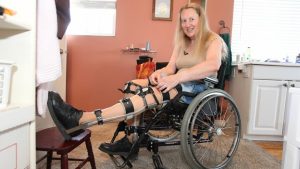Dina’s Diner 4/4/22
TRANS-WHAT?!
I came across an unsettling article in Canada’s The National Post. It was dated all the way back in June 2015 so I guess it’s something that popped up in a link or search. It was headlined Becoming Disabled by Choice, Not Chance: ‘Transabled’ people feel like impostors in their fully working bodies.
The article included this quote: “We define transability as the desire or the need for a person identified as able-bodied by other people to transform his or her body to obtain a physical impairment,” says Alexandre Baril, a Quebec born academic.” In short, healthy full-limbed people who want to be disabled through voluntary injury, amputation, or some other method. I did a Google search for “trans-abled” to make sure it wasn’t a hoax but I found other references to it as recently as this year.
The article includes cringe-inducing discussion of people maiming themselves so they will be disabled in some way — even blindness. It’s a real thing and is recognized as a mental illness but trans-abled people and some therapists want to have it considered a neurological disorder, “a problem with the body’s mapping” rather than a mental illness. To anyone who’s been around transgender issues for twenty or more years when the whole DSM (Diagnostic and Statistical Manual) controversy was red hot, this should sound very familiar.
The parallel (unfortunately, I think) to transgenderism is easy to make even if I may think it’s quite off-center. Remember how hard the haters tried to paint marriage equality for gay people as a slippery slope towards bestiality and pedophilia? Imagine if they trotted out bizarre “trans-abled” stories to cast doubt on genuine transgender identifications. Even as I write this I am wondering if I need to be more sympathetic to trans-abled people who just don’t feel right in their fully functional bodies. What biases might I (or you, if you’re hearing about this for the first time) be bringing to the issue? Where is the line? Should there even be a line?
IT’S A CINCH ONCE YOU GET USED TO IT
The online magazine Slate.com had an article headlined Bridgerton Keeps Perpetuating One of Hollywood’s Most Stubborn Myths. It was published online March 24, 2022. The myth in question had to do with a favorite fashion item of most crossdressers: the corset.
I didn’t watch Bridgerton when it ran on Netflix (with season 2 coming soon) but it was a cinch that I would read about corsets. I took a deep breath and let myself be drawn into the corset myth.
The article’s author, Hilary Davidson, is a fashion historian and expert on the types of Regency era fashions portrayed on the show. She begins the article, “Simone Ashley made headlines last week after mentioning in an interview in Glamour how painful and restricting her corsets were as the new leading lady in Season 2 of Bridgerton. She had problems eating, a lot of pain, and even thought she tore her shoulder at one point. Actresses in the show’s first season had similar complaints about the garment: Nicola Coughlan, who plays Penelope Featherington, said that “taking off a corset at the end of the day just feels incredible.” Davidson also references a quote from the show’s costume designer who said, “A corset will never be truly comfortable.”
Well, dear readers and corset lovers out there, Ms. Davidson begs to differ. She spends the rest of the article unlacing the myth “that all historical corsets were oppressive, painful devices of torture forced upon women for centuries. It’s simply not true.” Her exasperation is evident when she writes: “People often judge corsets by projecting modern standards of embodied comfort onto the past. Today, many of us live almost wholly in stretch clothing, especially since the pandemic began. Tighter, snug, and firm clothing had greater bodily comfort value ages ago, not least for warmth. Just because someone now can’t imagine wearing something stiffened around their torso doesn’t mean it was the same in the past.” The key is that corsets were commonly worn and women became accustomed to wearing them. Corset enthusiasts often use the term “waist training” when discussing their progress to achieve the desired hourglass shape.
Another factor that differentiates historical corset wear from today’s is addressed. “It’s also important that historical upper- and middle-class women had corsets made to fit them. Bodies are infinitely variable. Something so snug must be individualized to be comfortable. The Corset Myth has fed on many people trying an off-the-shelf-corset, lacing it too hard and fast, and creating pain.” This may be a point that is particularly important — and ultimately frustrating — for crossdressers. Trying to fit a normal male torso into an off-the-shelf womens’ corset is no easy task. I know I’m preaching to the choir here to some of you.
The article is filled with other interesting tidbits about corsetry in the olden days. There’s a discussion about breasts and corsets that I don’t have room to go into. But check it out. You may enjoy boning up on corsets and staying with the subject.
HELL ON HEELS
Has any piece of clothing spawned more controversy across the decades as high heeled shoes? Even the corset with all its baggage pales in comparison to a pair of high heels. I saw an article in The Harvard Gazette summarizing an academic discussion of high heels in the workplace recently. It was headlined Tracking the Effects of High Heels at Work and appeared on February 18, 2022.
It featured a discussion between Sreedhari Desai, a professor at the University of North Carolina’s business school, and a moderator at Harvard. Professor Desai recounted the results of a behavioral study she conducted “to understand how people evaluated women across a number of dimensions and in a variety of work scenarios — leading a class, giving a presentation, interviewing for a job, taking part in a negotiation — with the only variable being whether the woman was wearing high heels or flats. Time after time, women wearing flats were deemed more capable, more prepared, and earned higher evaluations from both men and women in their 20s through their 50s.”
The article mentioned that despite their divisive effect in work cultures, “heels are useful ‘power dressing’ tools for climbing the corporate ladder that boost confidence and convey authority. For others, they signify conventional notions of femininity that encourage sexual objectification and diminish career prospects. In any case, high heels are still widely seen as the most professional choice for women in many lines of work, from luxury retail sales and the airlines to investment banks and courtrooms, Desai said.” It also points out that some countries like Japan, Israel and United Kingdom allow employers to mandate high heels for female employees.
An article in the UK’s Guardian newspaper (here) by Tayo Bero draws on Desai’s study and points out the “sexist nonsense” surrounding high heels in the workplace. She writes, “There’s truly no winning. On the one hand, women working in corporate jobs, retail and the hospitality industry are often required to wear heels as part of their dress code. It’s a norm that’s built on centuries of dressing women according to the male gaze and forcing them to subscribe to misogynistic standards of femininity. But, as the study proves, women in heels are also taken far less seriously at work than women who wear flats.”
As a quick aside, I wrote an item in August 2021 about how female Ukrainian military cadets were drilling in high heels. It was sort of a fun item at the time. I don’t know what role the female cadets may be playing in the current war with Russia but Ukraine is holding tough on the ground so maybe they know what they’re doing in any kind of footwear.
There seems to be a lot of paradoxical psychology – perhaps psychosis – in the ongoing controversy about high heels. Are high heeled business women seen as ‘powerful’ because it exudes self-confidence or because of a sexualizing element that subconsciously works on the observer – even other females? Also, companies may require or prefer women employees to wear heels and they are willing to accept that doing so makes the women seem less competent at their jobs for those companies. Arrrgghh! We love ’em. We hate ‘em. But don’t stop wearing them.
TIME FOR A COME-BACK?
I saw a headlined article in a New York Times archive that intrigued me. The headline was What Happened to Vikki Dougan? The article originally appeared in the Times in April 2021. I was intrigued because I never heard of Vikki Dougan and if the Times wanted to know what happened to her. . .so did I.
Ms. Dougan was a former beauty contestant, model, and actress in the 1950s when she made a brief sensation at a Golden Globes ceremony in 1957. The Times article explained it this way: “a Hollywood newcomer named Vikki Dougan was about to present the award for Best Supporting Actor to Earl Holliman for his performance in “The Rainmaker.” Ms. Dougan had slipped on a pink satin backless dress for the special occasion and covered her shoulders with a mink stole. Before making her way to the stage to present, she realized she wouldn’t be able to hand off the award, shake Holliman’s hand and hold up her shawl at the same time. She gently let the mantle fall from her shoulders to the ground, revealing her toned, taut and impossibly shapely back as she made her way to the stage. From that moment onward, Ms. Dougan’s beautiful rear view became tabloid fodder for Hollywood gossip columns.”
As the Times reported, the Hollywood press covered her with groan-inducing puns. She “made marvelous exits,” she was a “ca-rear girl,” and “Vikki Dougan backs into a film career.” It was also said that some female headliners of the time disinvited her to parties so they didn’t have to compete with Dougan’s dramatic backless party gowns. Her gossip page nickname was appropriately “The Back.” Even though her Hollywood career was short-lived, it was said she was the inspiration for a pop song lyric and – more notably and many years later – as the inspiration for the Jessica Rabbit character in the 1988 film.
Vikki Dougan is still living, now 93 years old. As you can imagine, she’s got a number of health issues but still seems mentally alert. The Times reported, “Even at the height of her fame, Ms. Dougan always felt at odds with the racy reputation she had acquired. “It is not symbolic of who I am,” she said [of her notoriety]. “It wasn’t really me. I was playing a part. I didn’t even think there was anything even sexy about showing a back. It just didn’t occur to me.”
Even though it’s one of the largest body parts, it’s true the back is not thought of as a focal point of sex appeal. A number of years ago, Duchess Kate Middleton’s sister, Pippa, made a splash in a form fitting gown that showcased her hourglass shape and pear-shaped derriere when photographed from behind. That was the last time that I recall a woman’s back (not just her fanny) achieved notoriety. The photos of Vikki Dougan at the height of her appeal points out that it can be a very lovely part indeed.
ITSY BITSY SPIDER LASHES
I was browsing around the internet and saw an article that was headlined I Spend Twenty Minutes on My Eyelashes Every Day Only to Be Told They Look Like Spiders. The article appeared on The Mirror (a U.K. newspaper) website on March 10, 2022.
The article related the sad story of a young woman named Brenna who posted a video to TikTok about her eyelash problem. The Mirror article included some of the less-than-sympathetic comments about her eyelash game from viewers. For Brenna’s part, she says she spends 20 minutes on just her lashes “because if my lashes aren’t exactly how I want them I will literally have a bad day.”
I had never heard about eyelashes being criticized for spider-like qualities. But poking around on Google, I found that “spider lashes” is a thing. And not always a bad thing. Some fashionable women actually TRY to get their eyelashes to have a spidrous quality to them. It requires heavy application of mascara and a way to separate the lashes to create tendrils that may look like “spider legs.” The famous model from the 1960s Twiggy was the first to sport eyelashes that had long, separated, very mascara-ed black, pointed lashes. And fashion being always in the endless loop of reinventing looks from days gone by, spider lashes have been having a resurgence of sorts for the last several years.
I found an article from 2021 that gave a step-by-step guide to achieve the perfect spider lashes. The text of the article includes this bit of encouragement: “Lately, the world of makeup has become obsessed with spidery lashes. Instead of focusing on getting the lashes to look long and full, under this trend, they appear like a spider’s legs.” Go figure, huh?
Eyelashes are another one of those biological differences between men and women. Generally speaking, women’s eyelashes are naturally longer and more luxuriant than men’s. For crossdressers, mascara helps to bring out the lashes a little bit but they never quite get the same look as a biological woman’s natural lashes. False eyelashes are a great equalizer but many crossdressers seem intimidated by learning how to apply them. False eyelashes have also undergone a boom of late with many women opting to use them to enhance their look. And the cosmetic aisles are filled with a larger variety of false eyelashes than they were when I was beginning to experiment with them. They even have some false eyelash designs that provide the consumer with, yes, a spider lash. Don’t settle for Itsy-Bitsy male lashes when you can become Spider Girl.
Like to make a comment? Login here and use the comment area below.
Category: Transgender Opinion








